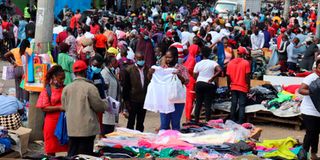How ‘mitumba’ debate put policymakers at crossroads

Second-hand clothe buyers and sellers at Gikomba market in Nairobi on June 13, 2021.
Kenya Vision 2030 long-term development plan identifies manufacturing as a critical pillar to the attainment of its terminal objectives. Kenya Industrial Transformation Programme (KITP), a well-planned project commissioned by the Industry ministry, shows the textile and apparel industry as a low-hanging fruit to accelerate manufacturing as envisioned in the ‘Big Four Agenda’.
A vibrant textile manufacturing sector would create value-chain benefits flowing down from farming cotton, weaving, spinning to the apparel industry, which will create employment for our youth. But that dream can only be realised with good quality of locally produced fabric or a mitumba (secondhand clothes) or manufactured fabric import ban.
Manufacturing equation
Manufacturing is the epitome of technology that crystallises all factors of production. Productivity can only be attained when the operating environment allows—abundant technically skilled workforce and availability of affordable raw materials, low logistical costs, affordable capital and markets.
The world’s industrial giants have lost a significant market share in the manufacturing equation and cannot find the right mix matrix. Most of their firms have relocated their manufacturing base to Asian countries that seem to get their configuration right.
In the US, the concern is so pertinent that any presidential contender is weighed on the basis of how he can manage the reversal of manufacturers’ flight.
A survey indicates that many Kenyans prefer mitumba because they are durable, trendy and affordable than new clothes. In fact, there are known importers of new clothes who pass them off as mitumba to entice customers. To reduce the unit cost of new garments, demand for them has to increase significantly. A policy of increasing import duty for new imported clothes will attract manufacturers.
To assume a possibility of locally generated mitumba may be far-fetched. Here, people use clothes exhaustively before disposal—unlike in developed countries, where people have higher disposable income and may wear clothes for only one season.
Circular economy
As the mitumba ban debate ranged, the Stockholm + 50 conference, themed “a healthy planet for the prosperity of all: Our responsibility, our opportunity”, hosted by Sweden and co-hosted by Kenya, was going on. It adopted a series of principles on the environment—including the Stockholm Declaration and Action Plan for the Human Environment. Having a circular economy was identified as part of the strategy to cut global warming to 1.5° Celcius.
Circular economy advocates optimum utility of manufactured products. It includes re-use or recycling of products, which results in less energy, and to minimise over-exploitation of resources.
If Africa is unable to competitively produce textile in a commercially viable sense, can a bargain for free secondhand clothes offset the employment quotient? Does it make sense to produce only to create employment if there can be a cheaper source?
Lt-Col (Rtd) Njiraini is the managing director of Kebs.





